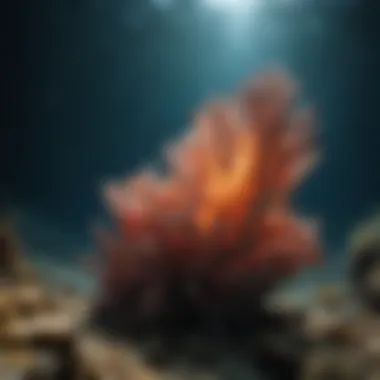Discovering the Deep Ocean: Fascinating Insights


Intro
The deeper you go into the ocean, the more intriguing it becomes. Beneath the waves lies a realm where sunlight barely penetrates, shot through with shadows and silence. This mysterious world is not just home to bizarre creatures or landscapes that look like they belong in a different planet; it plays a crucial role in regulating our Earth's weather, carbon cycles, and even our global food systems.
As a reminder, the importance of this vast underwater domain extends far beyond its captivating scenery. Marine ecosystems thrive in these depths, showcasing life that has evolved in isolation for millions of years. Yet, for all its wonders, the deep ocean remains one of the least explored frontiers on our planet, often leaving us guessing about the secrets it holds.
In the coming sections, we'll delve into fascinating tidbits about this underwater world, from its unique ecological systems to the geological wonders that lie beneath. But it’s not just about marveling at the sheer beauty; it's also about understanding the conservation challenges we face and the vital need for ongoing marine research. Knowing what lurks beneath the surface can help energize our commitment to protecting these critical areas and the life within them.
So, let’s plunge right in and start uncovering the extraordinary facts about the deep ocean.
Foreword to the Deep Ocean
The deep ocean represents a significant yet often overlooked part of our planet's ecosystem. Its depths harbor a multitude of wonders, from astonishing biodiversity to geological marvels that challenge our understanding of life and the earth itself. Recognizing the importance of the deep ocean sets the stage for a myriad of discussions, particularly in environments tied to outdoor sports, marine research, and global conservation efforts.
Defining the Deep Ocean
The term "deep ocean" typically refers to the part of the ocean that lies below 200 meters (656 feet). This area encompasses about 90% of the ocean's total volume and is often characterized by extreme conditions that are alien to most life forms we see at the surface. The deep ocean features various zones, such as the bathypelagic, abyssopelagic, and hadalpelagic zones, each hosting unique conditions regarding temperature, light penetration, and pressure. This classification is essential for understanding not just the types of species that inhabit these waters, but also their specific adaptations to survive in such a hostile environment.
The Importance of the Deep Ocean
The significance of the deep ocean goes far beyond its sheer size. It serves several crucial functions that impact global systems:
- Biodiversity Hotspot: Despite the challenging conditions, the deep ocean is a reservoir of undiscovered species, some of which could hold keys to breakthroughs in medicine and biotechnology.
- Climate Regulation: The deep ocean plays a vital role in modulating the Earth’s climate by regulating heat distribution and carbon cycling. It sequesters massive amounts of carbon dioxide, thus mitigating climate change impacts.
- Economic Resources: This area teems with minerals and potential energy resources. Activities such as deep-sea mining and oil drilling have sparked interests, although they also lead to environmental concerns.
The deep ocean is an undiscovered realm, holding secrets that could reshape our understanding of life itself.
By grasping the definition and importance of the deep ocean, we pave the way for deeper inquiries into its unique ecosystems and geological features. Awareness of this mysterious underwater world will not only foster appreciation for its beauty but also highlight the need for its conservation as we face growing environmental challenges.
Geographical Distribution of the Deep Ocean
Understanding the geographical distribution of the deep ocean is foundational for grasping the complexities of marine ecosystems and their roles in global processes. The vastness of the deep ocean is where biodiversity thrives under extreme conditions, making it a crucial area of research for both scientific and ecological considerations. Additionally, this section provides essential insights into where unique species make their homes and how these areas contribute to the larger marine environment.
Major Ocean Basins
The deep ocean comprises four significant basins—the Pacific, Atlantic, Indian, and Arctic Oceans—each with its distinct characteristics and geological features. The Pacific Ocean is by far the deepest and largest of the basins, hosting the Mariana Trench, which plunges to about 36,000 feet. In contrast, the Atlantic Ocean, while not as deep as the Pacific, is wider and supports the Mid-Atlantic Ridge, a significant site of underwater volcanic activity.
The Indian Ocean, known for its warm waters and diverse habitats, features the Java Trench, which is another crucial deep-sea area. Lastly, the Arctic Ocean, nestled around the North Pole, is relatively shallow but holds ice-covered regions rich in unique life forms adapted to extreme cold.
Each ocean basin has its own narrative, interwoven with distinct topographies and ecosystems, urging scientists to explore and understand their unique contributions to our planet's health.
Depth Zones and Their Characteristics
The deep ocean can also be categorized into various depth zones, each home to specially adapted organisms. The pelagic zone, which begins at the surface, extends down to about 2,000 meters, followed by the bathypelagic zone, reaching up to 4,000 meters, where light fails to penetrate. Deep-sea creatures here often exhibit adaptations like larger eyes to gather any light available.
Deeper still, the abyssopelagic zone, found between 4,000 meters and 6,000 meters, composes over 75% of the deep ocean. Life in this zone faces incredible pressure and frigid temperatures. Organisms are often gelatinous, enabling them to cope with the challenging environment, while some fish evolve bioluminescence for communication or hunting.
At the very bottom lies the hadal zone, beyond 6,000 meters, typically found in deep ocean trenches. Here, the adaptations are often extreme, with organisms with stands of genetic variability that researchers strive to understand.
These distinctions are vital—not only do they inform our understanding of habitat diversity, but they also highlight how alterations in one depth zone can ripple through the entire marine system, affecting everything from nutrient cycling to species survival.
Unique Ecosystems of the Deep Ocean
The deep ocean is not just a realm of darkness; it’s a thriving arena of unique ecosystems that play a crucial role in our planet's health. These ecosystems, often overlooked, harbor a remarkable diversity of life forms adapted to survive in one of the most extreme environments on Earth. By exploring these unique ecosystems, we gain insight into biological resilience, ecosystem services, and the overall significance of oceanic health.
Biodiversity in Extreme Conditions
In deep waters, conditions can be downright hostile. With crushing pressures, near-freezing temperatures, and little to no sunlight, organisms have evolved in fascinating ways to thrive in these seemingly inhospitable environments. For instance, the giant tube worm, which can reach lengths of up to eight feet, attaches itself to hydrothermal vents, utilizing chemosynthesis to convert substances like hydrogen sulfide into energy. This resilience is a potent reminder of life’s ability to adapt.
- Many deep-sea organisms possess unique features, such as:
- Luminous capabilities: Some predatory species use bioluminescence to attract prey or deter threats.
- Slow metabolism: Many organisms live at a snail’s pace, extending their lifespan significantly, sometimes to hundreds of years.


The biodiversity present in these extreme conditions contributes to the overall health of marine ecosystems, aiding in nutrient cycling and supporting food webs. In short, deep-sea life isn't merely surviving; it’s an intricate dance of adaptation that keeps the ocean’s heart beating.
Hydrothermal Vents and Their Ecosystems
Hydrothermal vents are like underwater chimneys, spewing heated, mineral-rich water from the Earth’s crust. These vents create oases of life amidst the barren ocean floor, hosting unique ecosystems that rely on chemosynthesis rather than photosynthesis. Among the shelly residents of these vent systems, tube worms and various crustaceans flourish. The vent communities offer a glance into how life could exist on other celestial bodies where sunlight doesn't reach.
Key Features of Hydrothermal Vents:
- Support for diverse life: While the surrounding seafloor might seem lifeless, these vents teem with life forms that have fascinating adaptations.
- Essential ecosystems: They contribute to fundamental biological processes, supplying energy in the absence of sunlight and offering habitats for various species.
Researchers continue to uncover more about these ecosystems every day, raising questions not only about our oceans but also about the origins of life itself.
Bioluminescence in the Deep Sea
Bioluminescence is one of the most captivating phenomena in deep-sea ecosystems. Organisms, ranging from tiny plankton to larger fish, emit light through chemical reactions within their bodies. This natural glow serves multiple functions:
- Attracting prey: Predators like the anglerfish use a bioluminescent lure to draw in unsuspecting prey.
- Communication and mating: Some species employ bioluminescence signals to communicate during breeding.
- Defense mechanisms: Creatures like the squid can release bioluminescent clouds to confuse predators, making their escape.
Bioluminescence not only creates spectacular displays but also illustrates the vast potential and adaptability of life in the dark depths of the ocean.
As we delve deeper into studying these unique ecosystems, we uncover the intricate relationships and evolutionary adaptations that have shaped the deep ocean. Understanding these exceptional life forms can enhance conservation measures and inspire us to protect these vital ecosystems for generations to come.
Geological Features of the Deep Ocean
The deep ocean is more than just a vast expanse of water; it is a realm marked by striking geological features that reveal the planet's history and dynamics. Understanding these features is crucial for grasping how they influence marine life, ocean currents, and even the climate. Through this section, we’ll focus on the significance of ocean trenches, seamounts, and submarine volcanoes, exploring how each contributes to the ecological and physical makeup of the deep sea.
Ocean Trenches
Ocean trenches are some of the most profound and mysterious structures on earth. They form at convergent tectonic plate boundaries, where one plate plunges beneath another, creating a deep, narrow trough. The Mariana Trench, for instance, stretches down to about 36,000 feet, making it the deepest known point in the ocean.
The significance of these trenches extends beyond their depth. They act as hotspots for unique species that have adapted to extreme conditions. Creatures like the amphipod can withstand the immense pressure found in these trenches. Additionally, ocean trenches are integral in the recycling of minerals and nutrients back into the ocean, influencing the broader marine ecosystem. The trenches also play a crucial role in understanding geological processes, including earthquakes and volcanic activity.
"Ocean trenches serve as nature’s laboratory, showcasing adaptation and resilience in the harshest environments."
Seamounts and Their Importance
Seamounts, or underwater mountains, rise from the ocean floor and can reach heights of over a thousand meters. These underwater giants often serve as significant ecological zones. They provide diverse habitats for a multitude of marine species, acting as oases of biodiversity. Areas around seamounts tend to be rich in nutrients, attracting various forms of marine life ranging from small fish to large predators like sharks and tuna.
Moreover, seamounts can help create localized currents, which enhance nutrient mixing in the water, making them hotspots for fisheries. With their peaks often shrouded in deep water, many of these seamounts remain less understood, representing a frontier for marine research. Their geographic distribution can also influence climate and oceanic circulation patterns, making them critical to global ecosystems.
Submarine Volcanoes
Submarine volcanoes, those hidden giants residing beneath the waves, provide insights into the planet’s geological activity. These volcanoes can form islands and, in some cases, create new landmasses. They play a key role in nutrient transfer as volcanic eruptions release minerals into the water, fueling nearby ecosystems.
Not only do these underwater volcanoes support distinct biological communities around them, but they also impact the surrounding water's chemistry, influence local weather patterns, and contribute to global carbon cycling. The Juan de Fuca Ridge is a prime example where volcanic activity has led to unique ecosystems thriving around hydrothermal vents, rich in sulfur and other minerals.
In summary, the geological features of the deep ocean serve as crucial factors influencing marine life and ecosystems. Understanding these features helps us appreciate the complexities of oceanography and its integral connections to global ecological networks.
The Physics of the Deep Ocean
The deep ocean, often seen as a mysterious frontier of our planet, is governed by a range of physical phenomena that significantly shape its environment. Understanding the physics at play is not just academic; it has practical implications for marine life, oceanography, and even human activities that rely on the ocean. Key aspects include the profound challenges posed by pressure and temperature, as well as how sound travels through these dark waters.
Pressure and Temperature Challenges
As one descends into the deep ocean, the first striking reality one faces is the relentless pressure. At depths exceeding 3,000 meters, the pressure can reach levels that would crush ordinary submarines and equipment.
- Effect on Marine Life: Organisms living in these dark waters have adapted through evolution. Some creatures possess flexible bodies, allowing them to withstand enormous pressures. Others have developed unique biochemical processes to survive where most life would perish. For example, the Giant Squid has a gelatinous structure that helps it manage the intense pressure.
- Temperature Variations: Coupled with pressure, temperature presents another significant challenge. In the deep ocean, temperatures can hover just above freezing, around 2 to 4 degrees Celsius. This cool environment leads to a decrease in metabolic rates for many marine species, which affects their growth, reproduction, and survival strategies. Fish like the Antarctic Icefish have antifreeze proteins in their blood, allowing them to thrive in such cold conditions.
Understanding these extremes is vital for marine biologists and oceanographers alike. The crushing pressure and frigid temperatures dictate not just how organisms live, but also influence ocean currents, which are crucial for global climate regulation.
Sound Propagation and the Deep
Sound behaves differently in the deep ocean compared to other mediums, primarily due to variations in temperature, salinity, and pressure. Oddly enough, despite the total darkness, sound travels further and faster underwater than it does in air.


- Speed of Sound: The speed can reach up to 1,500 meters per second, thanks to the denser water and favorable conditions. This propagation affects how marine mammals, such as whales, communicate over vast distances. Their songs echo through the depths, enabling them to maintain social bonds and navigate the ocean.
- Underwater Acoustics: Sound is also pivotal for research and exploration. Scientists use sonar technology to map the ocean floor and communicate with submersibles. Understanding sound propagation helps in gauging marine life behaviors and interactions. Additionally, innovations in hydroacoustic monitoring can assist in tracking fish populations and observing underwater geological activity.
"Sound travels on waves, weaving the stories of the ocean's depths. In ways we can barely comprehend, it links lives, ecosystems, and research."
In summary, grasping the physics of the deep ocean allows us to appreciate not just the biological wonders beneath the waves but also the critical role these oceanic properties play in global systems. For adventurers, researchers, and conservationists alike, recognizing these physical principles enables a more profound understanding of our planet's last frontier.
Marine Life Adaptations in Deep Waters
The deep ocean is a realm where life has evolved under extraordinary conditions, forced to adapt in ways that many would find astonishing. The adaptations of marine life in these dimly lit, high-pressure environments are crucial not only for the organisms themselves but also for understanding the broader implications for biodiversity and ecological balance. Exploring these adaptations reveals how life can endure and thrive in seemingly inhospitable conditions, shedding light on evolutionary biology and offering clues about resilience in the face of adversity.
Adaptations to Darkness
Living in the depths where sunlight barely penetrates demands remarkable changes in organism behavior and physiology. For many marine species, vision plays a crucial role in survival, but in the deep ocean, it's a question of how to see in nearly total darkness. Here’s where biochemical innovation comes into play. Many fish, for instance, have developed large eyes or eyes that are highly sensitive to light. Instead of using color vision, which is less effective in dark waters, species like the giant squid rely on ultraviolet perception to navigate their surroundings.
Moreover, some creatures have developed unique adaptations to cope without sight. The blind cavefish, for example, utilizes its sense of touch, relying on body sensors to detect minute water currents and find food. The term "bioluminescence" is quite often tossed around, but it’s worth exploring its importance. Deep-sea organisms like the anglerfish enhance their hunting efficiency and communication by emitting light through chemical reactions within their bodies. This not only helps in attracting prey but can momentarily dazzle predators, giving them a window to escape.
Feeding Strategies in the Deep Ocean
When it comes to feeding in the deep sea, life forms have an array of strategies that are as varied as the creatures themselves. Notably, the scarcity of food in such depths has prompted organisms to develop innovative behaviors and digestion mechanisms.
- Carnivorous Techniques: Predators utilize ambush techniques rather than chasing prey. The gulper eel is a prime example, with its massive mouth allowing it to gulp down prey almost as large as itself.
- Scavenging: Many deep-sea creatures have turned to scavenging. The giant isopod, for instance, is known to feast on carcasses that drift down from the surface, taking advantage of the nutrient leftovers in the ocean's depths.
- Filter Feeding: Some species, like certain types of sponge and whale sharks, have adopted filter feeding, filtering out tiny organisms and plankton from the water column.
The variety of feeding strategies reflects not only adaptability but also the intricate web of life in the deep ocean. Each adaptation contributes to the ecological tapestry of the deep sea, where the balance between predator and prey is delicately maintained.
Understanding these adaptations challenges our assumptions about life on Earth and highlights just how interconnected our ecosystems really are. Without these adaptations, life in such an extreme environment would not only be a struggle but perhaps unimaginable.
As we dig deeper into the oceans, the adaptations of marine life provide critical insights into resilience and the potential impact of changing climates on these underwater realms. Keeping the discussion lively around these topics helps to raise awareness about their intricacies and their relevance to environmental science.
In essence, the survival strategies of marine life in deep waters serve not just as a biological curiosity, but as educational touchstones that inform us about conservation efforts needed to protect these vital ecosystems.
Human Interaction with the Deep Ocean
The depths of the ocean aren’t just a remote location devoid of human presence; they are a dynamic space that resonates with stories of exploration, discovery, and environmental responsibility. Human interaction with the deep ocean has transitioned over the years from mere curiosity to a critical necessity as we uncover its profound significance to our planet. This section sheds light on various aspects of this interaction, focusing on the technologies we utilize, the methods we employ for exploration, and the pivotal role of submersibles in carrying out extensive research.
Exploration Technologies and Methods
The technological landscape for exploring the ocean depths has evolved drastically over the last century. In the beginning, we relied on simple methods such as bathymetric surveys and sonar systems to map the seafloor. Today, though, our tools have become remarkably sophisticated, enabling us to reach and investigate areas previously considered impenetrable.
Some of the most cutting-edge technologies include:
- Remotely Operated Vehicles (ROVs): Equipped with cameras and manipulators, ROVs allow scientists to observe underwater environments from a safe distance. They help collect samples and gather data in extreme conditions without putting human lives at risk.
- Autonomous Underwater Vehicles (AUVs): These uncrewed devices can navigate the depths independently, conducting tasks such as seafloor mapping and oceanographic data collection. Their ability to operate for prolonged periods makes them invaluable for research.
- Sonar Systems: Advanced sonar technology can penetrate larger depths, mapping vast areas and revealing geological features with astounding clarity. It's almost like shining a flashlight into a long-darkened corner of a room.
- Deep-sea Cameras: These specialized cameras take vivid photographs and videos in conditions that, to our eyes, would be pitch black. They help in documenting the incredible diversity of marine life.
The combined power of these technologies allows scientists to explore, observe, and record information about deep-sea habitats, contributing to our understanding and paving the way for more focused research.
The Role of Submersibles in Research
Submersibles, though not the most common sight, are key players in deep-sea exploration. They dive down to considerable depths, reaching areas that other equipment cannot, literally taking researchers into the heart of the unknown.
Two main types of submersibles exist: crewed submersibles and uncrewed vehicles. Crewed models often resemble miniature submarines, capable of housing scientists for extended periods while they conduct research firsthand. This direct interaction with the environment allows scientists not just to gather data but to experience the mysteries of the deep ocean directly.
- Crewed Submersibles
- Uncrewed Submersibles
- Deep-sea exploration: They can reach depths of over 11,000 meters, such as the DSV Alvin, which played a significant role in discovering hydrothermal vents.
- Scientific community engagement: Experiencing deep-sea phenomena visibly fosters a greater understanding of marine ecology.
- Cost-effective solutions: While still high-tech, these vehicles reduce the need for human presence, cutting down potential risks and costs.
- Automated data collection: Capable of performing tasks repetitively over time. This is crucial for long-term ocean monitoring projects.
The synergy between these exploration technologies and submersibles has opened doorways to discoveries that reshape our understanding of marine ecosystems and their intricate networks.
Understanding how human interaction unfolds in the deep ocean drives awareness of its importance. This journey into the murky waters not only elucidates the unseen life teeming below but also emphasizes our responsibility toward conserving these precious environments for future generations.
The Future of Deep Ocean Research
As we stand at the edge of the 21st century, the deep ocean remains one of Earth’s last frontiers, akin to exploring outer space. This vast, dark expanse holds not only humorous anecdotes of its depth but also forgotten treasures of knowledge awaiting discovery. Understanding the future of deep ocean research is crucial now more than ever. With threats from climate change and human activities, a fresh perspective on our oceans is necessary.


One key aspect that shapes the future of deep ocean exploration is innovation in technology. From autonomous drones to advanced submersibles, scientists deploy tools that offer unprecedented access to the ocean’s depths. These devices provide clarity on the delicate ecosystems residing far below the surface.
Emerging Technologies and Innovations
Emerging technologies have begun to alter the landscape of deep ocean research dramatically. Some notable advancements include:
- Autonomous Underwater Vehicles (AUVs): These drones can travel long distances without human intervention. They gather data on water temperature, salinity, and even biological activity. Oceanographic research can proceed even in areas too dangerous or expensive for manned missions.
- Robotic Submersibles: Vessels like the Alvin or the Deepsea Challenger enable scientists to explore regions that were previously inaccessible, unveiling new species and geological formations. They make extended stays at great depths possible, leading to richer data collection.
- Remote Sensor Technology: This tech can monitor ocean conditions continuously. Instruments can track changes in water quality, temperature shifts, or the effects of ocean acidification over time.
Investments in these technologies not only enhance data collection but also contribute to understanding climate-induced changes impacting marine ecosystems. Enhanced imaging systems provide clearer, more detailed views of the ocean floor, allowing researchers to map rich biodiversity with utmost accuracy.
"Technology allows us to peer into the depths of the ocean as never before, bridging the gap between us and this largely unexplored part of our planet."
As advancements evolve, focusing on sustainability will become increasingly important. This leads us to the cooperation on an international scale, providing a unified approach to tackle global ocean challenges.
International Collaboration in Marine Research
The future of deep ocean research also hinges on international collaboration. As we face global challenges like climate change and overfishing, sharing knowledge and resources becomes vital. Countries must unite their expertise and technologies in efforts to ensure the sustainable use of marine resources.
- Global Data Sharing Initiatives: Observing how ocean currents and temperatures fluctuate requires a collective effort. Several countries contribute to platforms that gather and share ocean data in real-time, making it a community responsibility.
- Joint Research Programs: Collaborative projects allow scientists to work on complex issues affecting the deep ocean. Through joint funding and resource sharing, nations can undertake large-scale expeditions that would be unfeasible individually.
- Marine Protected Areas (MPAs): These zones need agreement amongst nations to ensure protection against over-exploitation. MPAs require a worldwide effort to establish safe havens for marine life, safeguarding biodiversity for upcoming generations.
As the deep ocean faces immediate and looming threats, cohesive partnerships will provide the necessary framework to navigate these challenges. Future research not only aims at uncovering hidden secrets but also emphasizes proactive stewardship of this vital resource, ensuring our oceans can endure and thrive.
Conservation Challenges of the Deep Ocean
The deep ocean, despite being a realm rich in diversity and history, faces various conservation challenges that need careful examination. From climate change to pollution, the issues affecting these underwater ecosystems not only threaten marine life but also impact broader environmental health. Understanding these challenges is crucial for fostering awareness and implementing effective conservation strategies.
Impact of Climate Change
The repercussions of climate change are increasingly evident in the deep ocean. Rising temperatures affect the distribution of species, altering habitats that marine life has thrived in for eons. The thermal stratification of water can lead to decreased oxygen levels, creating a hostile environment for deep-sea organisms.
Moreover, the acidification resulting from increased CO2 levels poses a hefty risk to calcifying species such as coral and certain mollusks. As these organisms struggle to adapt, the entire ecosystem can face collapse, impacting not only the creatures living in these depths but also those that rely on them for food and habitat.
- Changes in migration patterns: Species may not be able to migrate to cooler waters as quickly as needed.
- Food web disruption: These changes can ripple through the food chain, creating further imbalances.
Pollution and Its Effects on Deep-Sea Ecosystems
Pollution is another pressing issue for the deep ocean. Notably, microplastics have infiltrated these depths, posing a significant threat to marine life. These tiny particles can be ingested by a wide range of organisms, from zooplankton to larger fish. The ingestion of plastic not only affects their health but also has implications for human consumption as toxins accumulate up the food chain.
Heavy metals and chemicals from industrial runoff accumulate in the sediments of the ocean floor, affecting organisms that inhabit these areas. The effects can often be long-lasting and difficult to reverse. As a result, the food web in these ecosystems suffers, leading to diminished biodiversity and resilience.
"Managing pollution in our oceans is not just a local problem; it’s a global concern that requires international cooperation to address."
- Effects of pollution include:
- Destruction of habitats through debris.
- Bioaccumulation of toxins in marine life.
Addressing these challenges is no small feat; it requires collaborative efforts across borders and disciplines. Sustainable practices must be the focus of our actions to protect the deep ocean and the innumerable species it holds.
Culmination: The Importance of Protecting Our Deep Oceans
The deep ocean represents the largest biome on Earth, a realm teeming with both undiscovered wonders and critical ecosystems. Recognizing its significance is paramount, particularly in an age where human impact reverberates through every corner of the globe. The deep oceans serve not just as habitats for countless marine species, but also as essential regulators of our planet’s climate, absorbing much of the carbon dioxide emitted into the atmosphere. Protecting these waters is thus not merely an environmental duty; it is a necessity for our own survival.
As explorers and scientists continue to uncover the secrets of the deep, they highlight the fragility of these ecosystems. For instance, coral reefs in the deep, often thought to be impenetrably remote, are quickly becoming victims of climate change and pollution. Efforts to conserve these habitats are crucial not only for the organisms that dwell there but also for human communities who rely on them for resources and livelihoods.
Various organisms in the deep sea have evolved unique adaptations, showcasing a level of resilience that holds keys to breakthroughs in medicine and biotechnology. The potential benefits for pharmaceuticals, bioengineering, and climate solutions from the deep are monumental. Yet, the destruction of these habitats could snuff out these opportunities before they even surface.
Going forward, our approach has to include sustainable practices, stringent regulations on deep-sea mining, and comprehensive international agreements to mitigate pollution and protect biodiversity. Individual and collective actions today will shape the underwater landscape for generations to come.
"The future of our oceans depends on responsible stewardship and a shared commitment to protect the beauty and diversity they sustain."
Future Directions for Research and Conservation
The challenges facing the deep ocean are enormous, but they are not insurmountable. Emerging technologies are paving the way for more effective exploration and conservation efforts. For instance, autonomous underwater vehicles (AUVs) and remotely operated vehicles (ROVs) revolutionize the way researchers gather data from the ocean's abyss. These advancements allow for extensive monitoring of ocean health and the behaviors of deep-sea species, which can help in crafting effective conservation strategies.
Furthermore, citizen science initiatives provide a platform for the public to partake in marine conservation efforts. By engaging sports enthusiasts and adventure seekers in underwater clean-up activities or monitoring biodiversity, we can create a community that values and protects these hidden wonders.
International collaboration is crucial as the oceans know no borders. Constructing a global framework for cooperation can enhance research capabilities and effectiveness. Communications between nations about the health of shared marine environments support a sustainable approach to ocean stewardship that is long overdue.
In summation, the need to protect our deep oceans is urgent. Future research must prioritize understanding these ecosystems and develop actionable strategies for conservation. Only then can we hope to preserve the delicate balance of life that dwells beneath the waves and ensure that the ocean’s depth remains a source of both inspiration and survival for years to come.







